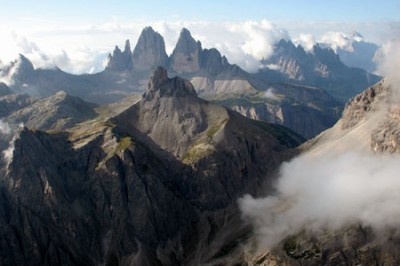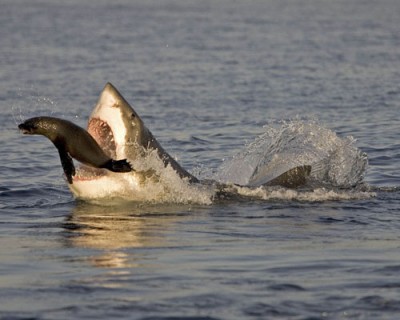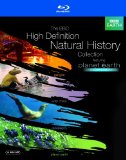| Reviews & Columns |
|
Reviews DVD TV on DVD Blu-ray 4K UHD International DVDs In Theaters Reviews by Studio Video Games Features Collector Series DVDs Easter Egg Database Interviews DVD Talk Radio Feature Articles Columns Anime Talk DVD Savant Horror DVDs The M.O.D. Squad Art House HD Talk Silent DVD
|
DVD Talk Forum |
|
|
| Resources |
|
DVD Price Search Customer Service #'s RCE Info Links |
|
Columns
|
|
|
BBC High Definition Natural History Collection (featuring Planet Earth), The
There doesn't appear to be anything new in this set, although Planet Earth does include a lot of extras not included in that title's initial Blu-ray release, in April 2007, though it does offer the same extra features that were part of a later, October 2011 reissue.
Therefore, for the interested consumer, what it boils down to is if you don't already own any of this material, then this is a fairly good bargain. Conversely, purchasing its components separately isn't a bad way to go, either. Amazon and other retailers are currently selling the set for around $90 (or 40% off the SRP). Purchasing everything piecemeal will run you about $100.
All four series - more than 19 hours of material, plus about nine hours of supplements - make great family viewing, something for parents and their children to watch together and talk about afterwards. Planet Earth particularly impressed and even awed viewers when it was new and it continues to do so today. However, its IMAX/Cinerama travelogue-like approach - dazzling viewers with absolutely incredible high-def imagery while adopting something of a natural science-lite breeziness - in retrospect, a decade into the high-def revolution, in some ways already seems a little dated.
All four series have been reviewed here at length before. Those looking for individual show critiques can link to my reviews of Ganges and Wild China, to Daniel Hershleifer's review of Galápagos , John Sinnott's review of the Limited Edition of Planet Earth and Michael Zupan's review of the less-expensive Special Edition.
I pretty much concur with my colleagues and their recommended reviews. I didn't re-watch Wild China or Ganges, but looked at everything else. Somehow I had completely missed Planet Earth (as well as Galápagos) and so while I'm pretty much in synch with what John Sinnott, Michael Zupan, and Daniel Herschleifer have to say about those shows, mine is from the slightly different perspective of seeing them for the first time in 2012, and not when they first aired or debuted on Blu-ray.
To that end I'm reminded a bit of the 1999 BBC series Walking with Dinosaurs, which had a similar though less pervasive impact on the DVD format in its early days. The then-dazzling widescreen video and CGI dinosaurs were terribly impressive back then, and the series still holds up today, though much more for its fascinating science than its dated visual effects.
The real draw of Planet Earth and its three companions here are the visuals. Those of us raised on Mutual of Omaha's Wild Kingdom, The Undersea World of Jacques Cousteau, and Disney's Tru-Life Adventures, programs typically shot in grainy 16mm, can especially appreciate the intimacy and epic quality of these BBC-NHK-Discovery Channel co-productions.
Lavishly produced (Planet Earth alone reportedly cost $25 million and took five years to shoot), each series takes full advantage and then some of the high-definition format. There's an abundance of spectacular, flawless aerial shots, particularly Cinerama-like audience-participation ones gliding between treacherous mountain peaks and stomach-churning fly-overs of vast waterfalls, looking straight down as if riding them in a barrel.
There's also much genuinely amazing time-lapse photography, often done as tracking shots, sometimes spanning several seasons. (My Japanese wife particularly enjoyed the explosion of pink watching Japan's cherry trees erupt into full blossom.)
While these shows visit the usual places: Antarctica, the Galápagos Islands, the Grand Canyon, etc., there are also visits to extraordinary, unimaginably alien places that truly look like the surface of some distant moon, locations so visually arresting it's surprising Hollywood filmmakers haven't swarmed in on them as exotic locales for 007 movies or as alien worlds.
The animal footage is equally amazing. From underwater footage of elephants swimming to the indescribably bizarre mating dance of the bird-of-paradise, this footage similarly takes full advantage of the high-def format, permitting a richness, variety, subtle color and pristine clarity simply not possible on standard-definition video.
That said the visuals are really the whole show. Planet Earth, despite its length and themed episodes ("Fresh Water," "Deserts," "Jungles"), and the other three, despite their location-specific subjects, tend to meander from one visually spectacular image to the next without a lot of in-depth analysis or scientific commentary. Instead, they're more like an endless collection of admittedly impressive "money shots," like the Cinerama travelogues of the 1950s. The shows also become rather repetitive and one-note. Planet Earth, for instance, endlessly alternates between wide, introductory landscape and animal migration vistas (e.g., thousands upon thousands of migratory birds clog the skies), mating rituals, and shocking-yet-hard-to-look-away footage of various carnivores stalking and savagely eating alive generally defenseless herbivores. Much of this footage, from great white sharks gobbling up unsuspecting seals to 30-foot crocodiles clamping their jaws on thrashing impalas and stork-like birds may upset young children, so parents be warned.
Each lightly touches upon the dangers of global warming on these often-fragile ecosystems while rightly and continuously marveling the cyclical, symbiotic balance of nature, but it's never sanctimonious and usually so subtle that it's difficult to imagine what all the recent controversy concerning Frozen Planet might have been about.
For the most part these programs let what's onscreen speak for itself, with Attenborough and the other narrators (Tilda Swinton on Galápagos, Bernard Hill on Wild China, and Sudha Bhuchar for Ganges) mostly offering little factoids about what the audience is seeing. (Again, like Cinerama. One can almost hear Lowell Thomas's booming newsman's voice, "For the first time anywhere, Cinerama's cameras take you inside the mouth of Kilauea!") The juxtaposition of the image and narration is almost always entertaining, but truth be told it could all fit on the back of a series of "Planet Earth" bubble gum cards.
Nevertheless, Attenborough's narration in particular adds exactly the human touch Planet Earth desperately needs. The now nearly 86-year-old younger brother of actor-director Richard, Attenborough's voice is authoritative yet grandfatherly and engrossing, and never ever pompous or stuffy. It's an interested, involved performance and a significant part of that series' appeal. That he would be replaced for the American broadcast versions of Planet Earth and Frozen Planet amounts to total madness. Swinton, Hill, and Bhuchar are perfectly fine narrating the other shows, yet one can't help but long for Attenborough regardless.
Video & Audio
If you read my earlier reviews of Ganges and Wild China you'll have noticed that I wasn't as impressed by the 1080i image on these shows as some. I don't really have a definitive answer as to why this is other than it's nothing more or less than my own personal reaction to what I saw. Watching Planet Earth and Galápagos I was much less critical, partly because by this point I knew what to expect visually, and also because I'd learned by then that the best way to enjoy these shows is to sit further from the monitor than I normally prefer, and where the limitations of 1080i are less apparent while the fundamentally spectacular images dominate.
The 5.1 DTS audio is fairly strong, with the musical scores coming off best though there is some nice directional mixing of ambient sound. 2.0 Dolby Stereo tracks offer narration in Hindi and Bengali on Ganges, and Mandarin subtitles are included on Planet Earth, which also includes Spanish and French subtitle options, while the remaining shows have English SDH only.
Extra Features
Each title features the same supplements, if any, included on the last previous Blu-ray release. Ganges and Wild China are light on extras and Galápagos has none at all, but Planet Earth more than compensates with a plethora of making-of and behind-the-scenes featurettes, most of which are in HD. Many of these programs are shows in themselves, including "Elephant Nomads of the Namib Desert," "Saving Species," "Snow Leopards: Beyond the Myth," etc. Five Planet Earth episodes include audio commentaries, and there's a music-only option, though it's more like a "narration off" feature as sound effects remain on the track. All told there's an additional nine hours or so of material, not counting the commentaries.
Parting Thoughts
If you don't have these series already, and especially if you have children, The BBC High Definition Natural History Collection is a great investment, like a subscription to National Geographic or a set of Encyclopedia Britannica (itself going out-of-print, alas). These are series that allow the viewer to experience much of the world and its natural wonders vicariously, and for a tiny fraction of the cost of, say, mounting a safari in Kenya or Scuba diving off the Great Barrier Reef. Though really more a visuals-heavy travelogue-like introduction to our planet's natural wonders than an information-packed scientific documentary, as such it's full of wonders and a DVD Talk Collector Series title.
Stuart Galbraith IV is a Kyoto-based film historian whose work includes film history books, DVD and Blu-ray audio commentaries and special features. Visit Stuart's Cine Blogarama here.
|
| Popular Reviews |
| Sponsored Links |
|
|
| Sponsored Links |
|
|
| Release List | Reviews | Shop | Newsletter | Forum | DVD Giveaways | Blu-Ray | Advertise |
|
Copyright 2024 DVDTalk.com All Rights Reserved. Legal Info, Privacy Policy, Terms of Use,
Manage Preferences,
Your Privacy Choices | |||||||














